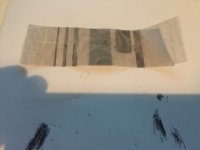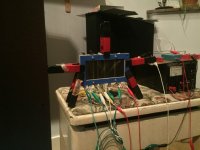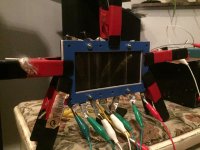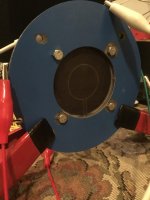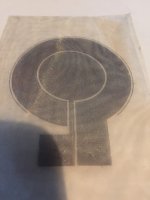https://onedrive.live.com/embed?cid...=661B00CA82FBAA7D!208&authkey=AFC4PB5IxZp3-74
Here i could not resist in making a recording of the contraption playing.
its a 5 stacked with 0.5mm dc spacing.with 3 micron foil. the stators dont have coating but still cna play pretty loud. crossed at 600hz, a bit to low, but better luck next time. measurement is pretty ok.
i did not get the thing to spark yet... but the whole thing is really picky about good connections. since i use the aligator clips this is sometimes an isue, and will result in arc's and all sorts of nasty stuff
Here i could not resist in making a recording of the contraption playing.
its a 5 stacked with 0.5mm dc spacing.with 3 micron foil. the stators dont have coating but still cna play pretty loud. crossed at 600hz, a bit to low, but better luck next time. measurement is pretty ok.
i did not get the thing to spark yet... but the whole thing is really picky about good connections. since i use the aligator clips this is sometimes an isue, and will result in arc's and all sorts of nasty stuff
Last edited:
well did some experiments. lowering resonance... not a good idea. the tension it gets from just a heatgun works best. but then i though what if i increase res on only the front and the back.
By squeezing the spacer the membrane is glued on and then heat it, so it will end up with a higher tension then when heated if the membrane is flat on a surface.
i was hoping to increase stability since my guess was that these are the ones flapping first. well the whole resonance of the whole system goes up. but it also compensates a bit for the low rolloff that i am still seeing.
further i fidled around with some felt and such. and some other minor tests with removing support structure for the front and rear stator mesh completly only the outer rim keeping all tiny 0.5 mmm pcb's stacked flat together.
it lowers distortion pretty well. it ranged from 0.35% to 0.08 % and a Bit 1% perscent at my famous 1khz peak. of witch i cant find the source. i can hear it clearly like a vibrating sound, but its is not the resonance , when i added felt the resonance went down from +8 db or so to 0 dB rolling off like a very steep crossover looks almost like a 48dB oct filter. so i dont know where to look.
a Bit 1% perscent at my famous 1khz peak. of witch i cant find the source. i can hear it clearly like a vibrating sound, but its is not the resonance , when i added felt the resonance went down from +8 db or so to 0 dB rolling off like a very steep crossover looks almost like a 48dB oct filter. so i dont know where to look.
i want that null gone my last hopes are it has something to do with the dimensions of the structure as a whole, since even a 1 stack has this weird null. Or its like the glue on quads. where the spacer meets the foil, it can create a nasty virbrating sound. normally only in low frequency's. but since this panel is sooo small it might shift into the 1khz range ? who knows. gone add some rubbery glue along the joints tonight.
my last hopes are it has something to do with the dimensions of the structure as a whole, since even a 1 stack has this weird null. Or its like the glue on quads. where the spacer meets the foil, it can create a nasty virbrating sound. normally only in low frequency's. but since this panel is sooo small it might shift into the 1khz range ? who knows. gone add some rubbery glue along the joints tonight.
now gone enjoy pizza and a beer
By squeezing the spacer the membrane is glued on and then heat it, so it will end up with a higher tension then when heated if the membrane is flat on a surface.
i was hoping to increase stability since my guess was that these are the ones flapping first. well the whole resonance of the whole system goes up. but it also compensates a bit for the low rolloff that i am still seeing.
further i fidled around with some felt and such. and some other minor tests with removing support structure for the front and rear stator mesh completly only the outer rim keeping all tiny 0.5 mmm pcb's stacked flat together.
it lowers distortion pretty well. it ranged from 0.35% to 0.08 % and
i want that null gone
now gone enjoy pizza and a beer
Hmmm ok the anoying peak dip and distortion at ~ 1khz is weird. when i put something in front of the stator (really close) it shifts down and distortion is normal , but its crap agin 50 hz lower. wtf is this ? could it be something with dimension of the panel? i tried the new glue and result was the same.
Thx calvin! thought about that to but was not sure if i had to devide it by 2 or 1/4.Hi,
if there's a dimension of around 17cm and multiples or fractions of that, it'll show as peaks or dips around 1k.
jau
Calvin
hmm well height is 108m mm and width is 50mm. so both dont really work out. still do think it has something to do with dimensions of the foil. there is only one way to find out i guess. Or it is the stator material refkecting some frequency back. but with a stator to stator distance of 1 mm i would expect that to be out of hearing range or at least certainly not be at 1.140 khz,
witch would then be 340/1140 /2 = 0.149 meter = 14.9 cm there is nothing that is close to that size.
only the width will fit in 3 times.
i tried adding a piece of doublesided foam tape to see if the frequency shifts because i make the surface area smaller, and it did.
hmm its anoying if i cant come up for a reason why its there would like to see a theorie that corresponds, not just a solution
One thing certain is that width of 5 and height of 10.8 is never a good idea since both are multiples of a frequency (or at least very near witch could explain the peaks and dips having to humps very close to one and another)
next time i will do some calculations before i just random use a height and width
hmm at least one thing of the list i now have successfully printed and etched the wire mesh. so i could make segmented stacked panels with mesh.
the smallest line was 1mm then 2 then 3 then some random ones. the 1 mm measures 1.3 ohm but the wires on there own say 0.3 ohm so 1mm is somewhere between 1 and 1.3. not that i would want to make such small lines. but its good to know. it can. i did forget to do a test where you can see how far the lines must be appart before it connects to each other. but 1 mm is def more then enough space in between conductive segments. maybe the high voltage requires even higher value.
the wax from the printer normally wont stick that well and ofcourse covers only one side. heating it up in an oven wil melt the wax and cover both sides. just trow it in the acid after
the smallest line was 1mm then 2 then 3 then some random ones. the 1 mm measures 1.3 ohm but the wires on there own say 0.3 ohm so 1mm is somewhere between 1 and 1.3. not that i would want to make such small lines. but its good to know. it can. i did forget to do a test where you can see how far the lines must be appart before it connects to each other. but 1 mm is def more then enough space in between conductive segments. maybe the high voltage requires even higher value.
the wax from the printer normally wont stick that well and ofcourse covers only one side. heating it up in an oven wil melt the wax and cover both sides. just trow it in the acid after
Attachments
yeah before anything happens in terms of rolloff it would be indeed into the 1K range or higher. still 1,mm seems a bit to fidly  prob gone keep it at 4 or something. also need to find a way to not waste so much of the mesh. since it pretty expensive.
prob gone keep it at 4 or something. also need to find a way to not waste so much of the mesh. since it pretty expensive.  for now i just fix my stretch jigg first. will keep this one smuldering
for now i just fix my stretch jigg first. will keep this one smuldering  definitly want to checkl this out further. in terms of a smallish tweeter/midrange with verry good dispersion, or something
definitly want to checkl this out further. in terms of a smallish tweeter/midrange with verry good dispersion, or something  maybe even look into using a horn or compression horn, since mutiple menbrames are used this could be an option. without having to funnel everything from a big stator into the horns opening. tobnad i dont know anything about horns. so might need some direction when i start
maybe even look into using a horn or compression horn, since mutiple menbrames are used this could be an option. without having to funnel everything from a big stator into the horns opening. tobnad i dont know anything about horns. so might need some direction when i start 
So first panel i made with this mesh since i ran out of the other mesh. but i tested if i could print etch resist on it. then remove the conductive coating to create sigments.
and i am really pleased with the result, pretty straight lines. (will make a better pic with some more light)
I used 1mm spacers this time since it was all i had laying around. but it still is a nice way to test if i could use polystyrene and test the sigment printing. and well it works.
polystyrene is not as rigid as the glass epoxy but because it is sandwiched between 2 pieces of very rigid HPL, the polystyrene spacers that hold either a stator mesh or a membrane, are gettign forced to be flat and stretch the mesh stator at the same time. And yeah polystyrene is like 1/4 the cost of glasfiber and is way way way nicer to cut
the picture is 2 stacks and it is sigmented in 5 parts, between every part is a 2 mm wide isolation line. the sigment to the left is for high frequency etc.
Gained a healthy 9 dB from one single esl to 2 stacked esl membranes. should be no more then 6 dB....... i also could increase bias, so something changed.
I did stretch the membranes a little tighter so might be it was a tiny bit more stable(3 dB more stable). although the resonance is still on 400Hz will post measurements later on when i managed to add some stacks and begin playing with the sigments. i used it now in full range to compare to my version 4.2
this mesh is pretty cool you can see trough it pretty well, its 3 layers of mesh and 2 x 1 micron thick mylar membranes but you can see the aligator clips on the backside pretty well.
but you can see the aligator clips on the backside pretty well.
and i am really pleased with the result, pretty straight lines. (will make a better pic with some more light)
I used 1mm spacers this time since it was all i had laying around. but it still is a nice way to test if i could use polystyrene and test the sigment printing. and well it works.
polystyrene is not as rigid as the glass epoxy but because it is sandwiched between 2 pieces of very rigid HPL, the polystyrene spacers that hold either a stator mesh or a membrane, are gettign forced to be flat and stretch the mesh stator at the same time. And yeah polystyrene is like 1/4 the cost of glasfiber and is way way way nicer to cut
the picture is 2 stacks and it is sigmented in 5 parts, between every part is a 2 mm wide isolation line. the sigment to the left is for high frequency etc.
Gained a healthy 9 dB from one single esl to 2 stacked esl membranes. should be no more then 6 dB....... i also could increase bias, so something changed.
I did stretch the membranes a little tighter so might be it was a tiny bit more stable(3 dB more stable). although the resonance is still on 400Hz will post measurements later on when i managed to add some stacks and begin playing with the sigments. i used it now in full range to compare to my version 4.2
this mesh is pretty cool you can see trough it pretty well, its 3 layers of mesh and 2 x 1 micron thick mylar membranes
Attachments
Made a tiny tweeter, produced only 2 stacks so far and did not use the segmentation yet since i need more output first  . but i am so pleased with the segmentation on the fabric, i think it is pretty stunning to get these nice segments on conductive fabric with such small traces. i really had a smile on my face when i got it out of the acid
. but i am so pleased with the segmentation on the fabric, i think it is pretty stunning to get these nice segments on conductive fabric with such small traces. i really had a smile on my face when i got it out of the acid 
i then had to dry it before i could test if there where any leakage path's at least on my normal meter up to 200 Meg no conductivity (first did not let it dry proper and thought i had to etch it longer until everything was goen ). the conductive traces measured from 0.2 to 0.7 Ohm
). the conductive traces measured from 0.2 to 0.7 Ohm
i then had to dry it before i could test if there where any leakage path's at least on my normal meter up to 200 Meg no conductivity (first did not let it dry proper and thought i had to etch it longer until everything was goen
Attachments
so i did some more tests, and there is a resonance at high volume in all the mesh stators. since they are not sturdy they have the ability to move , the same as the membrane, of course i knew this but it worked pretty well for certain frequency. i tested a single esl stack and had the same weird resonance be it lower. then i beefed it up by a eggc rate. the weird resonance went away. but for this aplication an egg crate wont work of course  but i must say this problem ocours at high volumes. its not the volume that makes it virbrate but the high voltage of the es transformer. so low bias result in the same weird distortion at lower volume. this wont make it usable for mid ranges. it still works well for 2Khz and up. witch makes me think small an head set or a in ear monitor might work stacking a few to getto the needed SPL. the membrame being very small as well as the stator will result in less of a problem for the resonance. for now i leave it that. i might once try a small one like 6mm small
but i must say this problem ocours at high volumes. its not the volume that makes it virbrate but the high voltage of the es transformer. so low bias result in the same weird distortion at lower volume. this wont make it usable for mid ranges. it still works well for 2Khz and up. witch makes me think small an head set or a in ear monitor might work stacking a few to getto the needed SPL. the membrame being very small as well as the stator will result in less of a problem for the resonance. for now i leave it that. i might once try a small one like 6mm small  but i first have to get in touch with chinsettawong since i think he tried something like that. so for now the stacked esl has to remain a PCB or a combination. i still think about how to make one that could work
but i first have to get in touch with chinsettawong since i think he tried something like that. so for now the stacked esl has to remain a PCB or a combination. i still think about how to make one that could work
- Status
- This old topic is closed. If you want to reopen this topic, contact a moderator using the "Report Post" button.
- Home
- Loudspeakers
- Planars & Exotics
- sandwich esl ?Yummie
